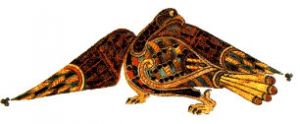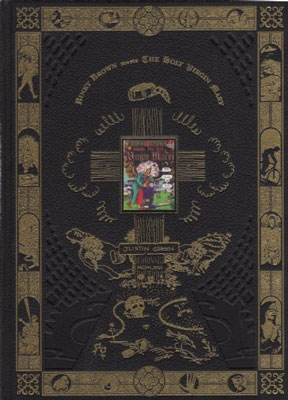Comics /
Spotlight /
Religion and Comics
Binky Brown meets The Holy Virgin Mary
By Beth Davies-Stofka
March 11, 2010 - 08:41
I was recently standing in the library of Trinity College Dublin, gazing at the Book of Kells.
In the dark, climate-controlled room, two volumes of this work of remarkable beauty lay open inside glass cases. I was face to face with the most famous illuminated manuscript in the world.
Believed to date to roughly the year 800 of the Common Era (or 800 AD, the "Year of Our Lord," as some would have it), the Book of Kells contains the four Gospels of the Christian New Testament. Before Gutenberg rolled out his printing press (ca. 1450), all books were handmade. Some of them were "illuminated," or elaborately decorated. The world's surviving illuminated manuscripts are priceless treasures of art, craft, and beauty.
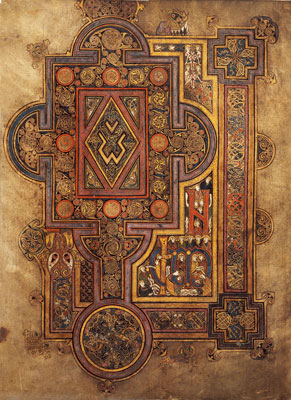 |
| A single word, "Quoniam" (Latin for "many"), takes up one whole page of the Book of Kells, a gorgeous example of the elaborately decorative style of illuminated manuscripts. |
Scholars have identified the hands of three, possibly four monks in the creation of the beautiful Book of Kells. The exuberance and complexity of the designs suggest the work was a labor of love. But it was also a labor of necessity, as the Book of Kells was not created for private reading, but for public worship. It was communally created, and communally experienced.
Nowadays, of course, the beautiful Bible from the monastery at Kells is never brought out for public worship. It must be protected if it is to be preserved. Somehow it survived the ravages of Viking invasions, theft, burial, Protestant-Catholic wars, and even a bookbinder who cut away a half an inch of the outer margins. Now the book's curators are determined that it will also survive the ravages of air, light, and too much handling. Time will not rob the Book of Kells from the storehouse of irreplaceable human treasures. Its protectors will see to that. This book is our inheritance and our legacy.
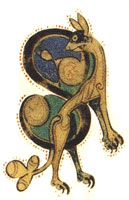 |
| The Letter S from the Book of Kells. |
And yet, curiously, as I stood there admiring the book, taking in the elegance of line and brush stroke, the sight of the fine grains of lapis lazuli still peppering the blue paint they helped pigment, the ways the thick red paint seeped across the thick vellum sheets, stopping just shy of the corners of the pages, I was surprised to find myself unresponsive. I'm not sure what I expected, exactly. Did I think bells would ring? Had I imagined a breathless sense of mystery, or awe, or even reverence? Did I hope to find fulfillment? Perhaps even Transfiguration? But as I admired these beautiful works, the monks' praise literally singing on the pages, and even as I thanked God for the opportunity to see them up close, I was already thinking, "I wonder what's in that next room? I wonder what's up those stairs?"
The days when these splendid artifacts possessed the power to liberate souls from evil and despair are gone.
I returned home from Ireland to McSweeney's December 2009 reissue of Justin Green's landmark 1972 comic Binky Brown meets The Holy Virgin Mary. To say that I was looking forward to this would be a gross understatement, and you should definitely buy it.
But nonetheless, I experienced a similar lack of response to this treasure as I did to the Book of Kells. Why didn't I cry? Why didn't I laugh? Why wasn't I shaken to my boots by some of Green's most shocking images? This painfully honest self-portrait of a Catholic child whose religious and sexual obsessions were deeply complicated by OCD is only 37 years old. That's hardly enough time for its impact to fade.
I blame the packaging. While I can understand the reverence with which Binky Brown has been returned to readers, I don't like the side effects.
This spectacular hardcover edition is 9" x 12", thickly bound in black and lavishly decorated (shall we say illuminated?) in faux gold leaf. Inside, the reader finds a faithful reproduction of Green's original art, allowing us to peer closely at lines, strokes, erasures, corrections, and even signs of the wear and tear of time.
The original 40-page comic is flanked by an introduction from Art Spiegelman and an afterward by Green. The borders of Spiegelman's introduction are also illuminated, not by faux gold leaf, but in black ink using a pattern suggestive of the complex interlacing, or "Celtic knot" pattern, used in ancient Celtic ornamentation such as that seen in the Book of Kells. The sense of the sacred is further enhanced by the inclusion of the ribbon bookmark sewn into the binding, in appropriately penitential purple.
The cover picture, pressed into the black hardcover, captures the comic's entire devastating story in one sublimely compressed image. Simultaneously Golgotha and tombstone, this cross on a hill bears the legend "Justin Green MCMLXXII" (1972), marking the date of the author's crucifixion. Hanging on the cross is the comic's original cover, the vehicle of Green's ruthlessly confessional agony. Above the cross, a Davy Crockett hat dances, anthropomorphizing this weird picture of a crucifixion without a body. The hat delivers a whiff of a long-ago childhood, one poignantly tainted by an invisible straitjacket of despair.
I'm going to insist on reading a resurrection into that Davy Crockett hat as well. I'll connect the resurrection to its freedom. No strings tie it down. It looks prepared to fly away, once it's done having a little fun.
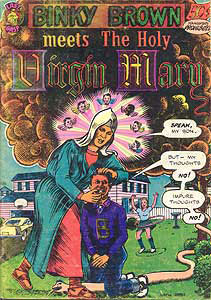 |
| The crucified cover of Binky Brown, 1972. |
I'm not sure I'm justified in doing this, but knowing the contents of the comic, I know that something more than crucifixion and death accompanied the momentous events described in 1972. I know that Green produced a method and means of salvation, a hermeneutic of emancipation from the mental slavery of oppressive religious indoctrination. Resurrection may be a long time coming, but Binky Brown is the pathfinder who reassures us that our own emancipation is possible, and that a soul at rest is in our sights.
But this edition's cover, its size, binding, decoration, and sacramental preservation of the imperfections in the original art, all conspire to chastise the reader, to remind her that the text she holds is sacred. It is, as McSweeney's website describes, the Autobiographical Graphic Novel, the emphasis on capital letters purposeful, reminiscent of the majuscule style of Irish illuminated manuscripts.
But are the days when Binky Brown possessed the potential to liberate souls from evil and despair past? Should Binky sit in a glass case in a dim, climate-controlled room, an emasculated artifact with great technical, historical, and cultural importance, but no innate power?
It depends on what you want from him. Do you want to be inspired, as Spiegelman was, to write your own Maus? I suppose the edition as is won't stand in the way of such inspiration. But Spiegelman and Green really suffered for their art. I honestly hope most of us can't lay claim to such intense personal pain.
Perhaps we have something else in common with Justin Green? The sexual perversions of religious leaders are just as monstrous today as they were during his childhood, manifested most publicly in their attacks on women and gay people. Their cruelties hurt people. The pain they cause is real. While the cause of Green's struggles are now (rightfully) attributed to his undiagnosed obsessive compulsive disorder, we shouldn't allow that revelation to obscure the context of his suffering, created by a religion that is sickened with sexual neurosis, and radically so.
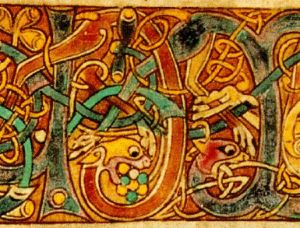 |
| Sample interlacing, or "Celtic Knot," from the Book of Kells. |
The Book of Kells is no longer an artifact of great power. For its own protection, it has been retired from its original purpose. I don't think we need to do the same thing to Binky Brown. Don't let this beautiful reprinting fool you. As much reverent care as has been poured into this edition, it is still mass produced. You can't damage the original. So be daring. Free Binky Brown from the past!
Buy this book. Buy it for the extra large sheets. Tear it out of its binding. Tape the pages to your walls, or better, string a line across your largest room and clip the pages to it with clothespins (remember those?). Live with this comic, while you gradually replace these pages with your own.
Access its power. Conjure a vision of your own freedom. Conjure a door while you're at it, and don't forget to walk through. And if you have a minute, do as Justin Green did in this intensely honest story, and as he did again in his erudite Afterward to this edition. Let us know how you did it.
Rating: 10 /10
Last Updated: January 17, 2025 - 08:20
